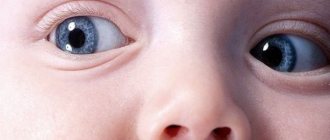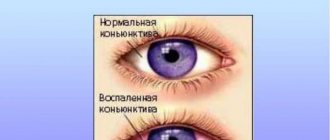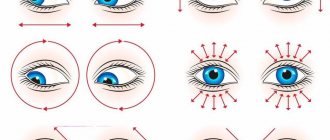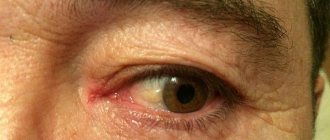Reasons and recommendations for parents during treatment
Often the root cause of conjunctivitis is infection through contact with a patient . With the disease, intensive formation of a thick secretion is observed, gluing the eyelashes. This is noticeable upon waking up and makes it difficult to open your eyes.
If, against the background of conjunctivitis, flu-like symptoms occur in the form of cough, fever, nasal discharge, and runny nose, then conjunctivitis is secondary. Its development occurs with the onset of the main pathology and after its completion.
Presence of hyperthermia
Conjunctivitis in children is often accompanied by hyperthermia (fever). This is a consequence of an imperfect immune system and a violation of the basics of personal hygiene.
The child’s temperature rises with the development of complications and consequences of conjunctivitis, that is, the appearance of another infection.
When it enters the body, the immune system is activated. In response, interferons are produced and body temperature rises. Viruses and bacteria cannot withstand hyperthermia of 38 °C or more . This is how the body fights inflammation.
The occurrence of viral conjunctivitis in children occurs simultaneously with a current respiratory tract infection, acute respiratory infections, influenza, measles, in this case the temperature level is initially 37-37.8 ° C. After some time (up to 12 hours) it increases to 38 °C. Adenoviral conjunctivitis is characterized by particularly persistent hyperthermia.
Even newborns are susceptible to bacterial conjunctivitis. It is also characterized by high hyperthermia - about 39 °C. In particularly difficult cases (pyretic fever), the temperature rises to 39-41 ° C and is resistant to antipyretics. To reduce it, a course of antibacterial treatment is carried out. Duration of fever is 4 days or more.
If your baby is coughing
With symptoms such as conjunctivitis accompanied by cough, runny nose, and watery eyes, an adenoviral infection most often occurs.
If you have a combination of cough, runny nose, watery eyes and conjunctivitis, use antiviral medications prescribed by your doctor.
But to alleviate the baby’s condition, the following methods are also suitable:
- A strong dry cough is relieved with the help of throat softening agents: syrups, tinctures, hot drinks - tea, herbal decoctions, infusions.
- For a runny nose and sneezing, use sprays, drops, and rinsing. If there is a dry cough, it is soothed with hot tea with mint.
- weak immunity;
If you have a stuffy nose or yellow or green mucus due to illness
Fighting a runny nose at the onset of the disease is wrong. Harmful substances are removed from mucus, so it is necessary to preserve its necessary properties. The use of special drugs is undesirable.
To keep the nasal passages constantly moistened, drinking plenty of fluids, ventilating the room, and clean air is enough.
Snot in children appears even due to temperature changes, infectious diseases, and weak immunity. Treatment is carried out using saline solution, decoction or infusion of chamomile, sea salt. In newborns, they are treated by lubricating the mucous membranes with various oils with vitamins A and E.
Vasoconstrictor medications can worsen the baby's condition.
To quickly relieve a child’s well-being, the use of special nasal drops is effective:
The following medications can be used for nasal instillation:
Antibiotic therapy is used to eliminate snot and reduce the child's temperature. This makes sense if there are obvious symptoms of acute respiratory infections, including influenza. The use of antibiotics in the treatment of disease in infants is undesirable .
If an infant has green snot with minor complications, using beet, carrot, and potato juices diluted with water in a ratio of 1:10 helps. They are rich in natural antibiotics.
The appearance of yellow snot in a baby is a sign of inflammation or ineffective treatment. The phenomenon is facilitated by pathologies of the respiratory tract and simple hypothermia.
Discharges appear as a result of:
respiratory tract pathologies;
For treatment, ready-made solutions are used, for example, Aqua Maris, Marimer, Aqualor.
For colds and ARVI
With a cold accompanied by conjunctivitis, complications are dangerous (in particular, keratitis, which sometimes provokes loss of vision). It is necessary to protect your eyes from direct sunlight with dark glasses. At the first symptoms, you should temporarily abandon contact lenses and replace them with glasses.
In the treatment of adenoviral conjunctivitis, the use of cold compresses and vasoconstrictor drugs helps. If a bacterial superinfection is detected, antibiotic therapy is necessary.
Conjunctivitis, cough and other symptoms of adenovirus infection
The first signs of this disease appear at the end of the incubation period. It generally lasts from one to two weeks. Initially, there is an increase in body temperature, a slight cough, weakness, and runny nose. The patient begins to complain that he has snot. Further symptoms appear later:
- Swelling on the face, mainly localized in the cheeks, eyes, and neck.
- The appearance of a runny nose, which is characterized by a complete inability to breathe through the nose.
- A dry cough that does not calm down even at night and manifests itself in the form of attacks.
- Lymph nodes on the body increase in size. This is especially true in the neck and armpits.
- Conjunctivitis, which is a characteristic feature of this type of viral infection. The baby develops lacrimation, photophobia, eyes fester and itch.
- With complications of this disease, there is an increase in the size of some internal organs, such as the liver or spleen, with persistent conjunctivitis and runny nose.
If you find a combination of symptoms such as cough, conjunctivitis, runny nose, lacrimation and fever, consult a doctor to prescribe the correct treatment. It usually takes several weeks.
If the patient's eyes itch, a runny nose, sneezing, coughing, or signs of conjunctivitis appear, then this may also be a sign of an allergic reaction. To find out this, you need to contact an allergist. The peculiarity of this disease is the absence of elevated body temperature.
Causes of conjunctivitis with a runny nose in a child
The main cause of conjunctivitis in children is microbes .
Often the disease begins after a runny nose , which occurs due to the introduction of infection by hand onto the mucous membrane of the eye, which is typical for children.
To avoid this, you should monitor sick children, wash your hands often and prevent conjunctivitis.
Conjunctivitis, which is accompanied by a runny nose, can be allergic, occurring due to external irritants - plant pollen, animal hair, dust, citrus fruits and other products.
Causes
What causes conjunctivitis of the eyes in children?
The disease is an inflammatory pathological process that affects the mucous membrane of the anterior segment of the eye. This disease can develop at any age, but most often it occurs before the age of 3 years. The most common cause of conjunctivitis in children aged 3 years is a bacterial infection that penetrates the organs of vision due to poor personal hygiene (rubbing the eyes with dirty hands, swimming in polluted waters, exposure to dust). Other causes of inflammation of the conjunctiva in children include:
- allergic reaction (mainly seasonal);
- decrease in the body's defenses;
- viral diseases;
- foreign body entering the eyes;
- eye damage from chemicals;
- prolonged irritation of the eyeball by smoke or dust;
- hypothermia;
- other ophthalmological pathologies;
- exposure to light rays.
In some cases, conjunctivitis is a side effect when taking certain medications or a consequence of metabolic disorders.
It is not always possible to determine the exact cause of the inflammatory process that occurs before the age of 3 years.
Conjunctivitis with a cold
If a child has a cold, cough, runny nose or nasal infection , then in most cases the disease is caused by bacteria or viruses of the adenovirus family.
Therefore, when visiting a doctor, an adenovirus infection will be diagnosed .
It belongs to the group of respiratory viral infections, which affects the membranes of the respiratory tract, organs of vision and lymphoid tissue.
It is precisely this that occurs with cold symptoms.
Symptoms of conjunctivitis
- the appearance of a crust on the eyes , which most often appears after sleep;
- swelling and swelling of the eyelids;
- irritation and itching in the eye (which causes the child to actively rub and scratch the eye).
If conjunctivitis is allergic , then the main symptoms are supplemented by a runny nose and sneezing .
Adenovirus infection is accompanied by inflammation of the eye membrane and cold symptoms : fever, runny nose, sore throat, cough.
When the first signs of the disease appear in children, you should make an appointment with an ophthalmologist , who will determine the cause of inflammation in the eyes and prescribe an effective medicine.
If for some reason a visit to the doctor is postponed, then it is worth providing first aid to the baby so as not to trigger the disease.
General approach
- use of antiviral and antibacterial drugs ;
- drugs with a vasoconstrictor effect;
- means for washing the inflamed eye;
- antihistamines and antiallergic drugs;
- physiotherapeutic procedures (ozone therapy).
First of all, strict adherence to hygiene rules is ensured .
The sour eye, on which crusts form, should be wiped with a cotton pad previously moistened in warm water.
When washing your face, you should stock up on a separate towel for each eye. If a child needs to wear contact lenses, then they should be abandoned during illness .
Medicines
If one eye is inflamed, you should pay attention to both , but for each there should be a separate cotton pad or clean gauze pad.
You need to wipe your eyes in the direction from the temple to the nose ; under no circumstances should you reuse the cotton pad.
Also, if you have conjunctivitis, you should not blindfold yourself, which provokes the proliferation of microbes and injures the inflamed eyelids.
When visiting a clinic, your doctor may prescribe the following medications:
- Disinfectant drops . Albucid solution, Fucithalmic, Levomycetin, Vitabact, Eubital, Tobramycin and others. At the beginning of the disease, they are instilled every few hours into both eyes. This is done to avoid infection of the healthy eye shell.
- Eye ointments. The doctor may recommend the following medications: tetracycline ointment, Floxal or another, which is placed under the lower eyelid.
For conjunctivitis in babies under one year of age, you should not use a pipette with a sharp end, otherwise you may accidentally damage the eye membrane.
The child is placed on a flat surface, one person should hold the baby’s head, and the other should pull back the lower eyelid and drop 1-2 drops.
The drug itself spreads throughout the eye membrane, excess medication is removed with a napkin.
When an older child resists burying his eyes and closes them, you should not yell at him or force him to open them.
You can drop it into the middle of your closed eye. When it is opened, the medicine will fall on the eye shell.
Otherwise, a closed eye can be gently opened with two fingers.
The drug from the refrigerator must be warmed in your hand to at least room temperature, otherwise additional irritation may occur.
As the condition improves and symptoms decrease, the number of eye washes and eye drops is reduced to 1-3 times a day.
When conjunctivitis is accompanied by another, no less serious illness or is protracted, then the doctor selects more serious treatment, including antibiotics .
For viral inflammation of the eye shell, drops with an antiviral effect are prescribed : Actipol, Trifludin, Poludan, and for herpetic inflammation, Zovirax or acyclovir ointments are prescribed.
With allergic conjunctivitis, first identified and contact with it is limited .
After this, you should take antihistamines and antiallergic drugs : Suprastin, Tavegil, Cromohexal, Opatanol, Allergodil.
In addition to treatment, you should seek help from an allergist.
Prevention
The main rule for preventing inflammation of the eye membrane is maintaining personal hygiene , which must be taught to children from a young age.
It is always better to prevent any disease than to see your baby suffer from symptoms and unpleasant treatment.
Therefore, you should follow the following rules :
- regularly and teach older children to do the same ;
- ventilate the room daily , monitor air humidity and use special cleaners;
- monitor the cleanliness of the baby’s bed and toys ;
- The child's diet should contain a lot of fruits and vegetables ;
- take daily walks in the fresh air;
- The baby must have his own towel;
- When using lenses, you should ensure proper storage and handling .
Symptoms
Conjunctivitis, like rhinitis, has different symptoms, but these two diseases are closely interrelated. Unlike rhinitis, which is always only a symptom of a particular disease, conjunctivitis can be a manifestation of an independent disease. The most characteristic symptoms of conjunctivitis in children are the following:
- Feeling of itching, burning in the eyes.
- Increased tear production.
- Redness of the eyes.
- Increased body temperature up to 39 degrees.
- Swelling of the eyelids.
- Photophobia;
- Sensation of a foreign body in the eyes.
- Mucous or purulent discharge from the eyes.
Article on the topic - The eyes and runny nose of a child are festering.
A runny nose in children is a symptom of many ENT diseases, but when it appears together with conjunctivitis, the range of diseases narrows significantly and indicates either an allergic reaction, or a viral or bacterial disease. With rhinitis, a child will have the following symptoms:
- Nasal congestion.
- Impaired nasal breathing.
- Mucous discharge from the nose.
- Tearing.
- Itching, burning in the nose and eyes.
If the cause of the disease is viral conjunctivitis or ARVI, acute respiratory infections, then the child’s body temperature will rise to 39.5°. The child will complain of increased fatigue, headache, body aches and other symptoms. If a runny nose and conjunctivitis occurs against the background of an allergic reaction, then the body temperature will be normal, or not exceed 37.2°.
A child may have a runny nose with any form of conjunctivitis. It is quite difficult to recognize the etiology of the disease without consulting a doctor. It is believed that with bacterial conjunctivitis, both eyes are affected, and with viral conjunctivitis, the inflammation affects only one eye, but can spread to the other. Conjunctivitis is a contagious disease, so if a child suffers from this disease, he should be protected from communication with other children.
Reasons and recommendations for parents during treatment
Often the root cause of conjunctivitis is infection through contact with a patient . With the disease, intensive formation of a thick secretion is observed, gluing the eyelashes. This is noticeable upon waking up and makes it difficult to open your eyes.
If, against the background of conjunctivitis, flu-like symptoms occur in the form of cough, fever, nasal discharge, and runny nose, then conjunctivitis is secondary. Its development occurs with the onset of the main pathology and after its completion.
Presence of hyperthermia
Conjunctivitis in children is often accompanied by hyperthermia (fever). This is a consequence of an imperfect immune system and a violation of the basics of personal hygiene.
The child’s temperature rises with the development of complications and consequences of conjunctivitis, that is, the appearance of another infection.
When it enters the body, the immune system is activated. In response, interferons are produced and body temperature rises. Viruses and bacteria cannot withstand hyperthermia of 38 °C or more . This is how the body fights inflammation.
The occurrence of viral conjunctivitis in children occurs simultaneously with a current respiratory tract infection, acute respiratory infections, influenza, measles, in this case the temperature level is initially 37-37.8 ° C. After some time (up to 12 hours) it increases to 38 °C. Adenoviral conjunctivitis is characterized by particularly persistent hyperthermia.
Even newborns are susceptible to bacterial conjunctivitis. It is also characterized by high hyperthermia - about 39 °C. In particularly difficult cases (pyretic fever), the temperature rises to 39-41 ° C and is resistant to antipyretics. To reduce it, a course of antibacterial treatment is carried out. Duration of fever is 4 days or more.
If your baby is coughing
With symptoms such as conjunctivitis accompanied by cough, runny nose, and watery eyes, an adenoviral infection most often occurs.
If you have a combination of cough, runny nose, watery eyes and conjunctivitis, use antiviral medications prescribed by your doctor.
But to alleviate the baby’s condition, the following methods are also suitable:
- A strong dry cough is relieved with the help of throat softening agents: syrups, tinctures, hot drinks - tea, herbal decoctions, infusions.
If you have a stuffy nose or yellow or green mucus due to illness
Fighting a runny nose at the onset of the disease is wrong. Harmful substances are removed from mucus, so it is necessary to preserve its necessary properties. The use of special drugs is undesirable.
To keep the nasal passages constantly moistened, drinking plenty of fluids, ventilating the room, and clean air is enough.
Snot in children appears even due to temperature changes, infectious diseases, and weak immunity. Treatment is carried out using saline solution, decoction or infusion of chamomile, sea salt. In newborns, they are treated by lubricating the mucous membranes with various oils with vitamins A and E.
Vasoconstrictor medications can worsen the baby's condition.
To quickly relieve a child’s well-being, the use of special nasal drops is effective:
The following medications can be used for nasal instillation:
Antibiotic therapy is used to eliminate snot and reduce the child's temperature. This makes sense if there are obvious symptoms of acute respiratory infections, including influenza. The use of antibiotics in the treatment of disease in infants is undesirable .
If an infant has green snot with minor complications, using beet, carrot, and potato juices diluted with water in a ratio of 1:10 helps. They are rich in natural antibiotics.
The appearance of yellow snot in a baby is a sign of inflammation or ineffective treatment. The phenomenon is facilitated by pathologies of the respiratory tract and simple hypothermia.
Discharges appear as a result of:
- weak immunity;
respiratory tract pathologies;
For treatment, ready-made solutions are used, for example, Aqua Maris, Marimer, Aqualor.
For colds and ARVI
With a cold accompanied by conjunctivitis, complications are dangerous (in particular, keratitis, which sometimes provokes loss of vision). It is necessary to protect your eyes from direct sunlight with dark glasses. At the first symptoms, you should temporarily abandon contact lenses and replace them with glasses.
In the treatment of adenoviral conjunctivitis, the use of cold compresses and vasoconstrictor drugs helps. If a bacterial superinfection is detected, antibiotic therapy is necessary.
Conjunctivitis and runny nose in a child
Conjunctivitis in a child can develop as a complication of a runny nose, or as an independent disease after the penetration of pathogenic microbes and allergens into the mucous membrane of the eye. The causes of conjunctivitis and runny nose in children are very diverse, but in 95% of cases their development is provoked by pathogenic bacteria and allergens. During a cold, the inflammatory process develops in the nasopharynx, then spreads to the conjunctiva of the eye, which causes symptoms characteristic of conjunctivitis. The second reason is considered to be the increased sensitivity of the child’s body to various allergens: plants, house dust, fungi, some foods and other factors to which the immune system reacts sharply.
Types of conjunctivitis and their manifestations
Depending on what caused the inflammatory process, the following types of conjunctivitis are distinguished:
- Viral. The most common form of the disease, which often goes away on its own without treatment. Occurs as a result of damage to the body by viral infections (ARVI, herpes, influenza). In most cases, viral conjunctivitis in children 3 years of age is caused by an adenovirus. The first symptoms of the disease appear at the end of the incubation period (4-14 days). When there is viral inflammation of the conjunctiva, a child experiences the following symptoms: hyperemia of the cornea, swelling of the eyelids, pain, burning in the eyes, itching, clouding of the cornea, increased sensitivity to light, lacrimation. Since the pathology often occurs against the background of a cold, signs of ARVI are observed (cough, sore throat, hyperthermia). Viral conjunctivitis is a contagious disease that can be transmitted through household contact and airborne droplets.
- Bacterial. Occurs as a result of damage to the organs of vision by bacterial flora. Most often, inflammation in children is provoked by the pathogens gonococcus and pneumococcus. The symptoms of this form of the disease are pronounced; in addition to hyperemia and swelling of the eyes, severe itching, burning, and a feeling of sand in the eyeball are observed. The distinctive symptoms of bacterial conjunctivitis are the separation of purulent contents from the eyes, the formation of yellow crusts, and sticking of the eyelids in the morning. A bacterial infection in a child usually affects one eye first, and then after some time the other.
- Allergic. A common form of the disease that occurs as a result of a child’s interaction with an allergen, which can be dust, wool, chemicals, and so on. The main manifestations of conjunctivitis are complemented by other allergic manifestations (runny nose, cough, rash, sneezing). To eliminate conjunctivitis, it is enough to stop contact with the pathogen.
- Fungal. The rarest form of the disease in children 3 years old, the cause of which is the increased activity of fungi. In most cases, the inflammatory process is provoked by yeast or mold fungi. You can suspect a pathology in a 3-year-old child based on the following symptoms: hyperemia of the eye membranes, lacrimation, fear of light, burning, itching, separation of clear fluid from the sclera. A distinctive manifestation of fungal conjunctivitis in a child is the formation of purulent blisters on the eyelids, which, after hiding, leave fistulas in their place. Inflammation of this form in children takes the longest to treat.
When diagnosing conjunctivitis in a 3-year-old child, it is very important to correctly diagnose the type of inflammatory process, since the specifics of therapy depend on this.
What are the dangers of conjunctivitis and runny nose for a child?
The runny nose and conjunctivitis themselves are not dangerous diseases, but in the absence of timely treatment they can provoke other diseases or become chronic. , blepharitis, keratitis, iridocyclitis, sinusitis, sinusitis and other diseases can develop Quite often, against the background of rhinitis, inflammation of the pharyngeal mucosa occurs, lymphoid tissue is damaged, which causes symptoms of pharyngitis and conjunctivitis , and the upper respiratory tract may be affected.
Treatment methods
Treatment of conjunctivitis and rhinitis in children is carried out as prescribed by a doctor and only after the underlying cause has been established. In order to determine the nature of the disease, the doctor prescribes a series of laboratory tests, the results of which will help determine the pathogen and prescribe appropriate treatment therapy.
Antimicrobial drug Sumamed
Treatment of conjunctivitis and runny nose in children is carried out comprehensively, using drugs for local and internal use . The acute course of the disease often requires the use of antibiotics, but such medications are prescribed only when the disease is viral or bacterial in nature, when severe symptoms are present, body temperature rises, or there is a risk of all sorts of complications. Basically, doctors prescribe broad-spectrum antibiotics: Sumamed, Augmentin, Ospamox, Fromilid and others, which are available in the form of a suspension for children. The dose of any antibacterial drug, as well as the duration of its use, is prescribed by the doctor individually for each patient.
An integral part of medical therapy is the use of drops for the eyes and nose . For severe runny nose and congestion, the doctor prescribes vasoconstrictor drugs: Otrivin, Nazivin, Nazol and others. You can use these nasal drops for no more than 5 days.
Oftalmoferon eye drops
Eye drops are used to treat conjunctivitis . So, for the bacterial form of the disease, doctors most often prescribe Tobrex, Albucid, Oftaquix . For viral infections - Florenal, Oftalmoferon, Poludan, Actipol , and for allergic ones - Lecrolin, Cromohexal, Vibrocil and others. The course of treatment and dose are determined by the doctor.
Washing is considered important in the treatment of inflammatory processes in the mucous membranes of the nose and eyes . As an eye wash for conjunctivitis, you can take herbal decoctions: chamomile, calendula, string . Children over 2 years old can use Furacilin solution or 2% boric acid . It is recommended to wash your eyes 3-4 times a day.
Isotonic saline solution Marimer
To care for the nasal cavity, it is recommended to use saline or isotonic solutions: Aquamaris, Marimer, Humer and others, which are excellent antiseptics for combating various pathogenic pathogens.
For frequent colds or conjunctivitis, the doctor will advise parents to pay attention to the state of the child’s immune system and may prescribe vitamin complexes or immunostimulants.
Drug treatment of conjunctivitis
The tactics for treating inflammation of the conjunctiva in a 3-year-old child depends on the type of pathological process.
Read in a separate article: Strabismus in newborns: causes and treatment
Viral
Treatment of viral conjunctivitis in a child is usually not prescribed, but in some cases it is still necessary to use the following anti-inflammatory medications:
- Albucid;
- Interferon;
- Zovirax;
- Florenal.
Additionally, it is recommended to wash both eyes with antiseptic solutions and strengthen the immune system with vitamin and mineral complexes.
The duration of treatment in children is 2-4 weeks.
Bacterial
How to treat this form of the disease? If the organs of vision are damaged by bacteria, a course of antibiotics is prescribed in a small dosage, which is selected on an individual basis. In addition, the following medications are prescribed:
- Tetracycline ointment;
- Levomycetin;
- Tobrex;
- Tsiprolet.
Before using eye drops and placing the ointment behind the lower eyelid, it is recommended to rinse the eyes with chamomile solution.
Allergic
How to treat allergic inflammation? If it is impossible to avoid contact with the allergen, the doctor prescribes the following medications:
- Allergodil;
- Dexamethasone;
- Allomide;
- Zyrtec.
Additionally, anti-inflammatory eye drops, moisturizers, and antiseptic solutions for washing the organs of vision may be prescribed.
Video
Prevention
Prevention of conjunctivitis, as well as rhinitis, in children consists of following certain rules, which will help significantly reduce the risk of developing these diseases.
- Monitor the child's hygiene.
- Do not touch your eyes with dirty hands.
- Before eating or coming home from outside, wash your hands with soap.
- Regularly boost your immunity.
- Spend as much time as possible outdoors.
- Avoid contact with sick people.
- Eat right, follow a daily routine.
Compliance with simple rules will not 100% protect a child from various viral or bacterial diseases, but at the same time it will significantly reduce their development and ease the course of the disease.
Bacterial
The causative agents of bacterial conjunctivitis are various bacteria. The eyes are usually affected:
- staphylococci,
- streptococci,
- pneumococci,
- gonococci;
- Klebsiella;
- Pseudomonas aeruginosa and Escherichia coli.
The bacterial form usually affects one eye.
This is an infectious disease that is transmitted:
- in direct contact with the patient;
- fecal-oral method;
when a child passes through an infected birth canal.
Bacterial conjunctivitis usually affects one eye, but if personal hygiene rules are not followed, the disease spreads to the second. In addition to general symptoms, the following are also noted:
- purulent viscous dirty yellow discharge (not always);
- in the absence of pus - dry conjunctiva;
- sticking of eyelids during sleep;
- pain and sensation of a foreign body in the eye.
Attention! Bacteria do not cause swollen lymph nodes. If you find this symptom, you can say that the cause of inflammation is a viral infection. The bacterial form is treated with local medications containing antibiotics - drops and ointments
But they need to be used carefully, so first visit a doctor to rule out a viral infection
The bacterial form is treated with local preparations containing antibiotics - drops and ointments
But they need to be used carefully, so first visit a doctor to rule out a viral infection
A brief overview of the remedies that can treat bacterial inflammation of the conjunctiva is given in the table below. All of them are broad-spectrum drugs (effective against most bacteria), except Levomycetin. These drops help only with eye damage from gonococcus, Klebsiella, Pseudomonas aeruginosa and Escherichia coli.
| Name | Form | Age | Method of treatment | Active components | Price |
| Levomycetin 0.25% | Drops | From 4 months | 1 drop 3-4 times a day. The treatment period is from 3 to 10 days. | Chloramphenicol | 15 rub. per bottle 10 ml |
| Phloxal 0.3% | Drops | 1+ | 1 drop in each eye. 2-4 times a day until recovery, but no more than 2 weeks. | Ofloxacin | 175 rub. / 5 ml |
| Ointment | Place a strip 15 mm long behind the eyelid 2-3 times per day for 1-2 weeks. | 150 rub. per tube 3 g | |||
| Tobrex 0.3% | Drops | 0+ | 1 drop in each eye every 4 hours for 5-10 days. | Tobramycin | 185 rub. / 5 ml |
| Ointment | Place a strip 1.5 cm long behind the eyelid 2-3 times per day. Treatment lasts 5-10 days. | ||||
| Tetracycline 1% | Ointment | 8+ | Place 3-5 r/d strips 10-15 mm long behind the eyelid. | Tetracycline | 45 rub./3 g |
| Sofradex | Drops. | 1+ | 1 drop into the conjunctival sac every 4 hours until recovery. | Framycetin, gramicidin, dexamethasone. | 315 rub. / 5 ml. |
Tetracycline is effective in fighting bacterial infection.
Typically, the bacterial form of conjunctivitis goes away in 5-7 days.
In severe cases, the disease lasts up to 2-3 weeks. The body does not form a strong immunity to this disease, so it can recur.










